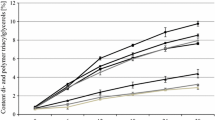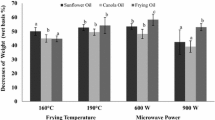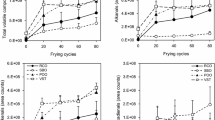Abstract
The endogenous minor components from canola, rice bran, sesame and palm oils including selected phospholipids, and various combinations of tocopherol isomers were tested during frying using canola oil triacylglycerols as the frying medium. Thermo-oxidative degradation was assessed by measurement of the total polar components, the rate of volatile carbonyl compounds and 4-hydroxynonenal formation. All the tested minor components protected to a different extent canola triacylglycerides from thermo-oxidative degradation during frying. No significant differences were observed in the protection of the triacylglycerides among all the tested tocopherol isomers and their mixtures. Irrespective of the composition of tocopherol homologous, an increase in the added amounts above 1,000 μg/g did not improve protection. Minor components isolated from rice bran and sesame oils offered better protection during canola triacylglycerides frying than endogenous minor components isolated from canola oil. When 0.2% phosphatidylcholine or phosphatidylethanolamine was added to the canola triacylglycerides, the amount of formed polar components decreased twice as compared to the tocopherol isomers. Accordingly, by optimizing the composition and the concentration of the endogenous minor components, the frying performance of oil can be significantly enhanced.









Similar content being viewed by others
References
Chiang TA, Wu PF, Ko YC (1999) Identification of carcinogens in cooking oil fumes. Environ Res 81:18–22
Chiang TA, Wu PF, Wang LF, Lee H, Lee CH, Ko YC (1997) Mutagenicity and polycyclic hydrocarbon content of fumes from heated cooking oils produced in Taiwan. Mutat Res Fund Mol Mech Mutag 381:157–161
Qu YH, Xu GX, Zhou JZ, Chen TD, Zhu LF, Shields PG, Wang HW, Gao Z (1992) Genotoxicity of heated cooking oil vapors. Mutat Res 298:105–111
Gertz C, Klostermann S, Kochhar PS (2000) Testing and comparing stability of vegetable oils and fats at frying temperature. Eur J Lipid Sci Technol 102:543–551
Clemente TE, Cahoon EB (2009) Soybean oil: genetic approaches for modification of functionality and total content. Plant Physiol 151:1030–1040
Neff WE, El-Agaimy MA (1996) Effect of linoleic acid position in triacylglycerols on their oxidative stability. Food Sci Technol Leb 29:772–775
Neff WE, Mounts TL, Rinsch WM, Konishi H, El-Agaimy MA (1994) Oxidative stability of purified canola oil triacylglycerols with altered fatty-acid compositions as affected by triacylglycerol composition and structure. J Am Oil Chem Soc 71:1101–1109
Fuller G, Kohler GO, Applewhite TH (1966) Fatty acid composition and oxidative stability of cold-pressed edible seed oils. J Food Sci 68:1240–1243
Bhatnagar AS, Prasanth Kumar PK, Hemavathy J, Gopala Krishna AG (2009) Fatty acid composition, oxidative stability, and radical scavenging activity of vegetable oil blends with coconut oil. J Am Oil Chem Soc 86:991–999
Lampi AM, Hopia A, Piironen V (1997) Antioxidant activity of minor amount of γ-tocopherol in natural triacylglycerols. J Am Oil Chem Soc 74:549–554
Abuzaytoun R, Shahidi F (2006) Oxidative stability of alga oils as affected by their minor components. J Agric Food Chem 54:8253–8260
Normand L, Eskin NAM, Przybylski R (2006) Comparison of the frying stability of regular and high-oleic acid sunflower oils. J Am Oil Chem Soc 83:331–334
Normand L, Eskin NAM, Przybylski R (2001) Effect of tocopherols on the frying stability of regular and modified canola oils. J Am Oil Chem Soc 78:369–373
Romero N, Robert P, Masson L, Ortiz J, Gonzalez K, Tapia K, Dobaganes C (2007) Effect of α-tocopherol, α-tocotrienol and Rosa mosqueta shell extract on the performance of antioxidant-stripped canola oil (Brassica sp.) at high temperature. Food Chem 104:383–389
Onal B, Ergin G (2002) Antioxidative effects of alpha-tocopherol and ascorbyl palmitate on thermal oxidation of canola oil. Nahrung 46:420–426
Wanasundara UN, Shahidi F (1994) Canola extract as an alternative natural antioxidant for canola oil. J Am Oil Chem Soc 71:817–822
Shahidi F, Wanasundara UN (1994) Stabilization of canola oil by natural antioxidants. In: Ho CT, Hartman TG (eds) Lipids in food flavors. ACS Symposium Series, Washington, pp 301–314
Xu XQ, Tran VH, Palmer MV, White K, Salisbury P (2000) Chemical, physical and sensory properties of Monola oil, palm olein and their blends in deep frying trials. Food Aust 52:77–85
Farhoosh R, Kenari RE, Poorazrang H (2009) Frying stability of canola oil blended with palm olein, olive, and corn oils. J Am Oil Chem Soc 86:71–76
Farhoosh R, Kenari RE (2009) Anti-rancidity effects of sesame and rice bran oils on canola oil during deep frying. J Am Oil Chem Soc 86:539–544
Alireza S, Tan CP, Hamed M, Che Man YB (2010) Effect of frying process on fatty acid composition and iodine value of selected vegetable oils and their blends. Inter Food Res J 17:295–302
Serjouie AS, Tan CP, Mirhosseini H, Che Man YB (2010) Effect of vegetable-based oil blends on physicochemical properties of oils during deep-fat frying. Am J Food Technol 5:310–323
Mezouari S, Eichner K (2007) Evaluation of the stability of blends of sunflower and rice bran oil. Eur J Lipid Sci Technol 109:531–535
Kim MA, Matoba T, Hasegawa K (1988) Relationship between the triacylglycerol composition and foaming of mixed coconut oil under deep-fat frying. Agric Biol Chem 52:693–699
Possanzini M, Di Palo V (1995) Determination of olefinic aldehydes and other volatile carbonyls in air samples by DNPH-coated cartridges and HPLC. Chromatographia 40:135–138
Lampi AM, Kamal-Eldin A (1998) Effect of α- and γ-tocopherols on thermal polymerization of purified high-oleic sunflower triacylglycerols. J Am Oil Chem Soc 75:1699–1703
Miraliakbari H, Shahidi F (2008) Oxidative stability of tree nut oils. J Agric Food Chem 56:4751–4759
AOAC (1990) Official methods of analysis of the association of official analytical chemists, 15th edn. AOAC, Arlington, Virginia
Schulte E (2004) Economical micromethod for determination of polar components in frying fats. Eur J Lipid Sci Technol 106:772–776
Firestone D (2009) Official methods and recommended practices of the American Oil Chemists’ Society, 6th edn. AOCS Press, Champaign
Rudzińska M, Muśnicki C, Wąsowicz E (2003) Phytosterols and their oxidized derivatives in seeds of winter oilseed rape. Rośliny Oleiste 24:51–66
Przybylski R, Klensporf-Pawlik D, Anwar F, Rudzińska M (2009) Lipid components of North American wild rice (Zizania palustris). J Am Oil Chem Soc 86:553–559
Khachik F, Goli MB, Beecher GR, Holden J, Lusby WR, Tenorio MD, Barrera MR (1992) Effect of food preparation on qualitative and quantitative distribution of major carotenoid constituents of tomatoes and several green vegetable. J Agric Food Chem 40:390–398
Silversand C, Haux H (1997) Improved high-performance liquid chromatographic method for the separation and quantification of lipid classes: application to fish lipids. J Chromatogr B 703:7–14
Aladedunye F, Przybylski, R. Carbon dioxide blanketing impedes the formation of 4-hydroxynonenal and acrylamide during frying. Eur J Lipid Sci Tech (Accepted)
Warner K, Moser J (2009) Frying stability of purified mid-oleic sunflower oil triacylglycerols with added pure tocopherols and tocopherol mixtures. J Am Oil Chem Soc 86:1199–1207
Frankel EN (2005) Lipid oxidation, 2nd edn. The Oily Press, Dundee
Matthews RF, Scanlan RA, Libbey LM (1971) Autoxidation products of 2,4-decadienal. J Am Oil Chem Soc 48:745–747
Seppanen CM, Csallany AS (2002) Formation of 4-hydroxynonenal, a toxic aldehyde, in soybean oil at frying temperature. J Am Oil Chem Soc 79:1033–1038
Chung J, Lee Y, Choe E (2006) Effects of sesame oil addition to soybean oil during frying on the lipid oxidative stability and antioxidants contents of the fried products during storage in the dark. J Food Sci 71:C222–C226
Chung J, Lee J, Choe E (2004) Oxidative stability of soybean and sesame oil mixture during frying of flour dough. J Food Sci 69:C574–C578
Hemalatha S, Ghafoorunissa (2007) Sesame lignans enhance the thermal stability of edible vegetable oils. Food Chem 105:1076–1085
Kashima M, Cha GS, Isoda Y, Hirano J, Miyazawa T (1991) The antioxidant effects of phospholipids on perilla oil. J Am Oil Chem Soc 68:119–122
Bandara NM, Campos RM, Batista I, Nunes ML, Empis JM (1999) Antioxidant of α-tocopherol and phospholipids. J Am Oil Chem Soc 76:905–913
Ramadan MF (2008) Quercetin increases antioxidant activity of soy lecithin in a triolein model system. LWT Food Sci Technol 41:581–587
Dobarganes C, Marquez-Ruiz G, Velasco J (2000) Interaction between fat and food during deep-frying. Eur J Lipid Sci Technol 102:521–528
Kourimska L, Pokorny J, Reblova Z (1994) Phospholipids as inhibitors of oxidation during food storage and frying. Prehrambeno Technol Biotechnol Rev 32:91–94
Murano Y, Funabashi T, Sekine S, Takeuchi H (2008) Improvement in storage stability of fish fillet using dietary soybean phospholipids. Food Sci Technol Res 14:55–61
Hidalgo FJ, Nogales F, Zamora R (2008) The role of amino phospholipids in the removal of the cito- and geno-toxic aldehydes produced during lipid oxidation. Food Chem Toxicol 46:43–48
Acknowledgments
This work was financed by the Alberta Value Added Corporation, the Agriculture Funding Consortium project #2006F018R and Bioactive Oil Program.
Author information
Authors and Affiliations
Corresponding author
About this article
Cite this article
Aladedunye, F.A., Przybylski, R. Frying Performance of Canola Oil Triacylglycerides as Affected by Vegetable Oils Minor Components. J Am Oil Chem Soc 89, 41–53 (2012). https://doi.org/10.1007/s11746-011-1887-8
Received:
Revised:
Accepted:
Published:
Issue Date:
DOI: https://doi.org/10.1007/s11746-011-1887-8




